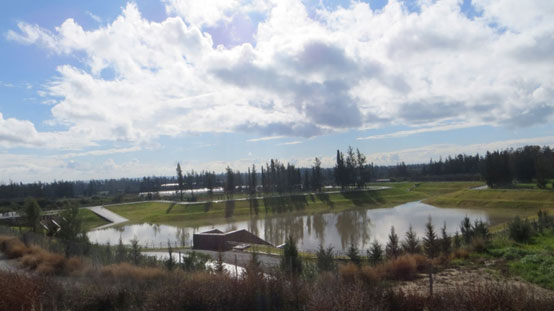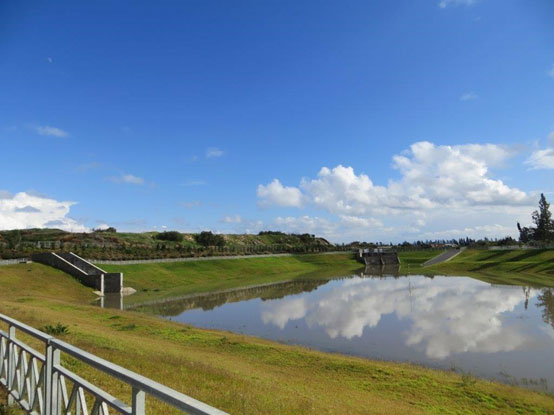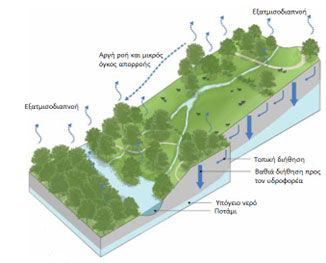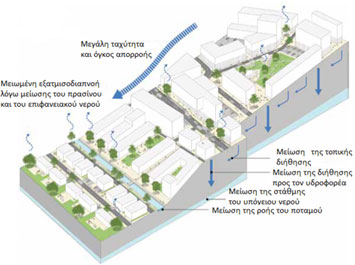Sewerage - Sustainable Stormwater Management
Kato Polemidia Stormwater Retention Lake
As part of the implementation of the Greater Limassol Stormwater Management Plan, with financial support from the State and the EU, the Kato Polemidia Stormwater Retention Lake was designed and constructed.
The SBLA is promoting modern stormwater management methods through the use of Sustainable Drainage Systems. The retention lake forms part of the flood prevention projects for western Limassol, designed by the SBLA, and was constructed alongside the roadworks of the Vertical Road Project by the Public Works Department.
This Lake has a capacity of 75,000 m³ and has been built on a 3.3-hectare plot purchased by the SBLA with the authorisation and consent of the State. The perimeter and slopes of the lake are mostly covered with grass, covering a total area of 19,000 m², while approximately 1,000 trees and shrubs have been planted around its perimeter.
The Lake captures the first flush of rainwater, holding debris carried by the stormwater drain of the Vertical Road, which has a transport capacity of approximately 35 m³/s. It collects the initial 2-3 m³/s of the flow (first flush flow), while the remaining quantities continue their course through the Vertical Road drain and discharge into the sea near the port. In the event of heavy rainfall exceeding 35 m³/s, which would surpass the drain's capacity, the entire flow is diverted to the lake and then discharged into the sea and/or the Akrotiri Salt Lake.
When the lake’s water volume exceeds 9,000 m³, excess water overflows through two Φ1000 pipes back into the stormwater drain of the Vertical Road. This ensures that, after each heavy rainfall, the lake retains only up to 9,000 m³, maintaining sufficient space for the next rainfall event. In rare extreme weather events, if the lake approaches its maximum level, water will be channelled through the overflow pipe into the Salt Lake. At the water outlet facilities, automatic electric grates have been installed to remove debris and prevent it from entering the overflow pipe and eventually reaching either the Salt Lake or the sea.
This is a landmark project that serves as a model for Sustainable Drainage Systems in Cyprus. It aims to manage rainwater near the area where it falls, considering not only quantity but also water quality. The lake will provide multiple benefits, including:
- Rainwater filtration, as some of the water will be retained and infiltrated into the ground.
- Retention of rain debris and pollutants, preventing their discharge into the sea or the Salt Lake.
- Recharge of the water table.
- Delaying stormwater flow and reducing peak flood intensity.
- Creation of a green space.
- Enhancement of the local landscape.


The Organisation’s Policy on Sustainable Stormwater Management System:
The Organisation promotes a unified policy for implementing Sustainable Stormwater Management Systems.
The key measures included in SSMS are as follows:
- Construction of retention ponds, where feasible, and utilisation of existing natural lakes for sediment retention, infiltration, and peak flow volume reduction.
- Avoiding surface sealing in open spaces and using permeable paving and road surfaces to facilitate infiltration and reduce surface runoff.
- Implementing earthen drainage channels where possible, installing non-sealed pipes, and constructing stormwater infiltration pits on public roads and other areas to help replenish groundwater.
- Minimising stormwater discharge onto public roads from private properties through stricter development permit regulations.
- Promoting a common policy for building permits by applying standard conditions and specifications for local authorities to enforce.
- Specifically, new planning and building permits will include conditions ensuring the reduction or retention of stormwater reaching the road network, such as:
- Mandatory construction of stormwater infiltration pits for all new buildings, particularly in open spaces. Henceforth, all building permits will include a condition requiring the installation of stormwater infiltration pits.
- Installation of stormwater infiltration pits in all basements and semi-basements.
- Use of water pumps to remove rainwater in case of water accumulation in these spaces.
- Construction of permeable pavements and sidewalks where practical and feasible.
- Implementation of earthen drainage channels wherever possible.
Key Benefits of SSMS Implementation:
- Flood prevention
- Reduction in surface runoff volume
- Decrease in storm drain overflows
- Reduced need for large stormwater drainage systems
- Groundwater recharge
- Environmental quality improvement
- Enhanced water quality and protection of natural water bodies
- Improved microclimate conditions (e.g., temperature reduction, shading)
- Resource, energy, and water conservation
- Creation of green spaces and recreational areas
- Carbon dioxide (CO₂) absorption and storage
- Biodiversity enhancement

